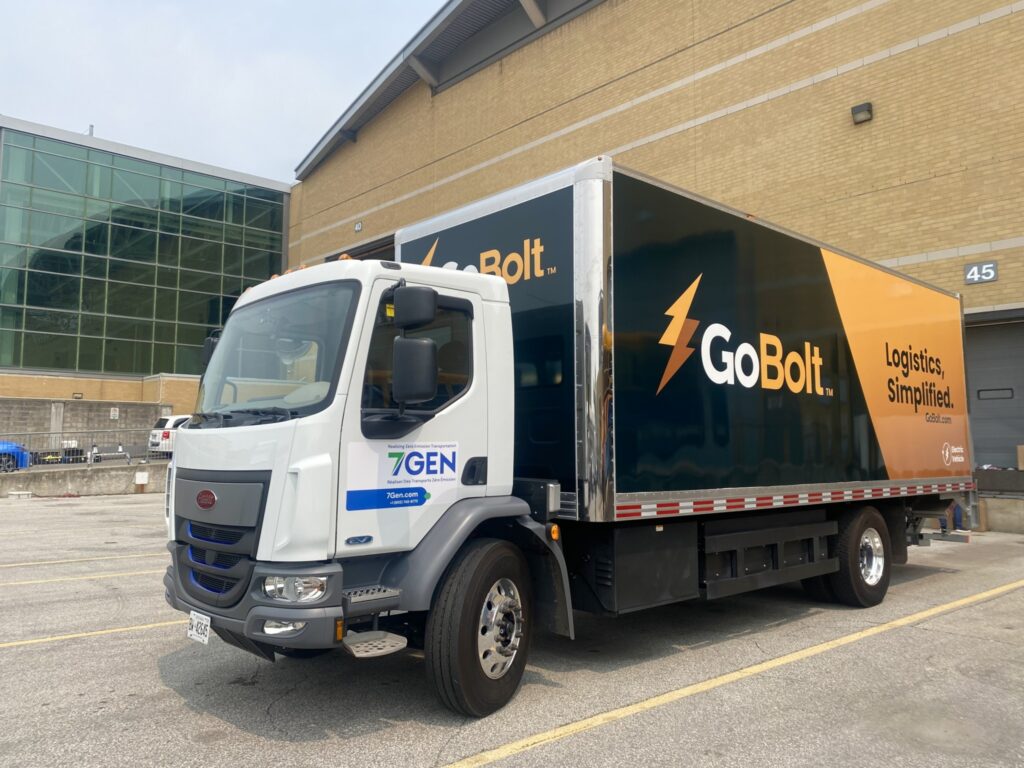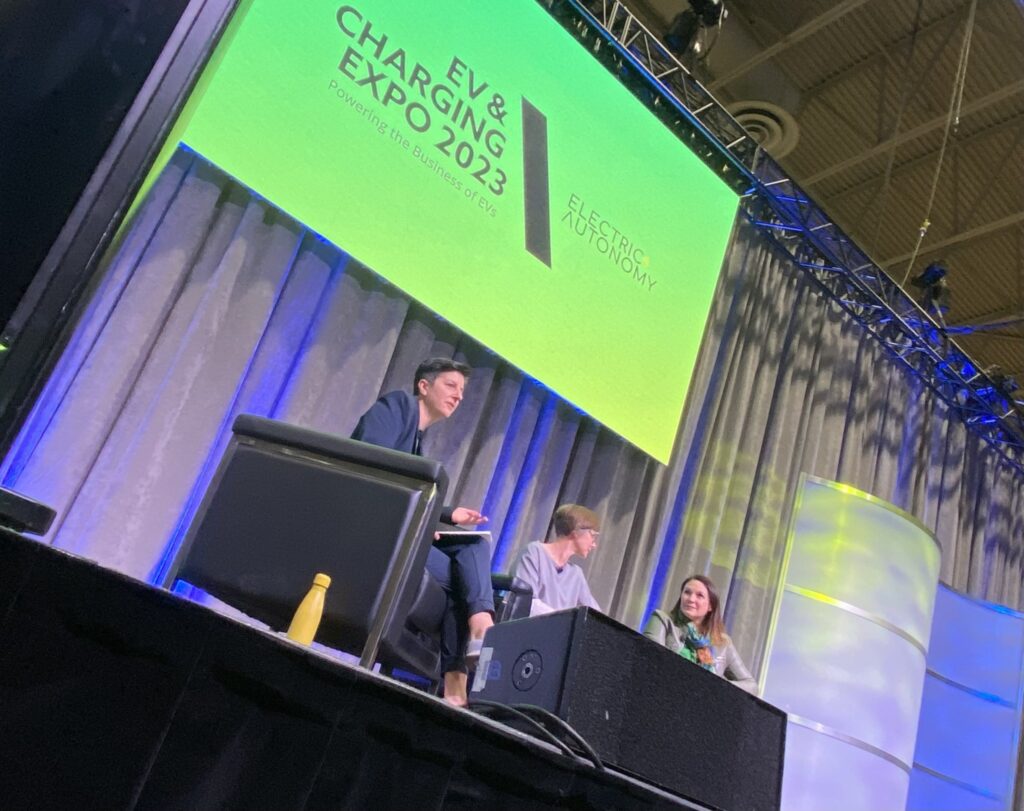7Gen deploys Class 7 truck, learns lessons on electric vehicle journey
The latest battery-electric vehicle deployed by 7Gen is in a class unto itself – the first Class 7 Peterbilt 220EV sourced by the EV-as-a-service provider, and the first of its kind in Canada.
“Finding a vehicle that had that trade-off — that could do the range the client needs, while still being able to carry the weight for that density of goods — has been tricky,” 7Gen vice-president, strategic partnerships Shayna Rector Bleeker said on the show floor of the EV Charging & Charging Expo.
The business has been waiting a year for it, and the truck has even been leased to GoBolt for its Ontario operation despite the lack of provincial incentives for electric vehicles. But it is seen as a great fit to support Ikea deliveries and a broader zero-emission vision.

Over five years the truck with a 24-foot box will slash an estimated 200 tons of CO2 emissions, matching levels that would be generated by burning a rail car full of coal. And 7Gen adds that fleets save 40-50% of traditional maintenance and fuel costs when operating electric trucks.
“As a company, we are on track to provide carbon-neutral deliveries by the end of 2023,” GoBolt CEO Mark Ang said in a press release. “Sustainability isn’t achieved by one company’s efforts alone and it’s not without its challenges. It takes working and partnering with like-minded businesses to move the needle.”
7Gen has deployed just under 100 electric vehicles and hopes to double that total by the end of the year, Rector Bleeker said, referring to rollouts in Ontario, B.C., and Quebec. (Charging infrastructure is currently being established in Alberta as well.) Build slots have been secured on assembly lines, and deposits have been paid to secure access to equipment that will add to the mixture of Ford eTransit, Lion6, and Lightning ZEV3 cargo vans, and GM Brightdrop 600s.
It’s part of the layered support the company offers to fleets, sourcing vehicles that fit individual needs, establishing charging infrastructure, and securing the all-important financing to make early electric applications a reality.
Early lessons with electric vehicles
“It’s not been a smooth road all the time, but lately we’ve had days with more super-smooth roads than bumpy roads,” said Crystal Rasa, customer fulfillment sourcing manager at Ikea, which has turned to 7Gen for support in its electrification journey.
On the ‘super-smooth’ days, people stop to take selfies with the electric trucks. “Being early adopters is challenging and at the end of the day I’d ultimately like it not to be selfie-worthy … I don’t want it to be special,” she said during a panel discussion with Rector Bleeker.
But the retailer wants to learn where such trucks are the best fit in the journey to slash emissions.
There’s plenty to learn, too.
“We’ve focused very much on the primary markets – cities with the densest populations,” Rasa said. Such environments include the shorter trips that tuck into today’s available electric truck ranges. “We really, really have to be careful mapping out our routing around the charging.”
But she balks at any suggestion that electric vehicles will struggle in Canada’s colder climate. Ikea itself began with six battery-electric trucks on a snowy day in Montreal back in 2021.
“Anyone who says it can’t be done in Canada – yes it can,” Rasa said, noting that the retailer is also prepping a Quebec distribution center to shift shunting activities to battery-electric trucks.

Ranges, temperatures, and driver impacts
At this stage, 7Gen advises customers to pick routes of less than 150 miles, even though manufacturers promise ranges above 200 miles with selected models.
“How’s it going to perform over the winter? We don’t know yet,” Rector Bleeker told TruckNews.com, referring to early rollouts. In one case, a cargo van lost more than 40% of its range on the coldest days of the year. Even the average box trucks lost 35%.
Driver behavior impacts that too, though. “Educate the drivers on how to gamify that regenerative braking piece, to really think and be mindful on colder days. You’ve got to play it smart,” she said, adding the business now spec’s divided cabs and boxes so that only the cab needs to be heated in frigid conditions.
One “practical and slightly frustrating” option during early rollouts may even involve using diesel-fueled refrigeration units. “Clearly that’s not a zero-emission solution,” she said. But it’s a compromise that needs to be made if it can convince someone to try the trucks.
Firmware updates and charging infrastructure
While electric powertrains themselves are proving to be relatively trouble-free, challenges can emerge with frequent firmware updates in early models, she added. That can temporarily interfere in the virtual handshakes between trucks and chargers.
“A provider that is focused and understands this technology is a really great partner to a fleet manager in these early days,” she said. Otherwise fleets are left to chase answers about chargers, software and trucks on their own.
Even sourcing the charging infrastructure can represent some of the biggest challenges of all.
“On the charging infrastructure side, we’re having real supply chain limitations on switch gears and transformers, which means we’re having to say, ‘Don’t deliver the vehicle until November or January,’” Rector Bleeker said. Then there are delays in securing consent from landlords or connections from utilities.
The models to support a handful of trucks are relatively easy to complete. But once the plans expand to consider 20 to 30 vehicles, there’s usually a need to involve a second utility line, adding another one or two years to the timelines.
Financing electric trucks
Perhaps the biggest challenge involves sourcing the financing companies willing to back such ventures.
“They’re not super open to it,” Shayna Bleeker said. “No one can say they know what the residual value of that asset will be. We’re going to run them for a decade first. We assume these will be valuable assets, we assume there’ll be a value for the battery.”
Ikea helped with related negotiations by accepting a longer contract to demonstrate its commitment, she said.
“The sooner other retailers take this step and jump in and do it, the sooner the technology will advance, the sooner it will become commonplace,” Rasa says. And the more commonplace it becomes, the more affordable it will be.
“There’s a lot of knowledge in this country. We actually make these vehicles here,” Rector Bleeker mused, referring to Quebec-headquartered Lion Electric as an example. B.C. is even one of the first jurisdictions to have a functioning carbon market, where electric fleets can claim low-carbon fuel credits. But Canadians can be better at starting such work rather than pursuing it with a focus, she said.
“We’ll do better as a country if we decide what we’re going to do, where we’re going to do it.”
Have your say
This is a moderated forum. Comments will no longer be published unless they are accompanied by a first and last name and a verifiable email address. (Today's Trucking will not publish or share the email address.) Profane language and content deemed to be libelous, racist, or threatening in nature will not be published under any circumstances.
I don’t know why companies are taking chances on their EV tuck purchases. Even the legacy truck makers are new to the EV game while Lion Electric has a 10 year history and experience with vehicles in all sorts of weather and road conditions.
WINTER / COLD THE KILLER OF EV TRUCK FOR NOW